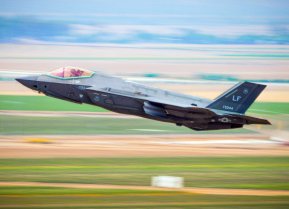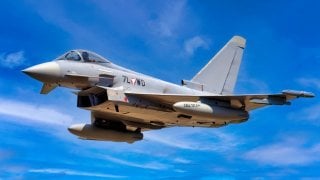Eurofighter Typhoon: The Warplane Built to Strike Anything
Development of the Eurofighter Typhoon began in 1986, with the establishment of the Eurofighter consortium that involved the three countries – Germany, Italy, and the UK – that had worked to develop the Panavia Tornado.
Four Royal Air Force EurofigterTyphoon FGR4s aircraft, supported by a Voyager air refueling tanker, carried out a strike on Houthi rebel positions in Yemen this week. According to the UK's Ministry of Defense, the aircraft launched Paveway IV guided bombs to conduct precision strikes on two of these Houthi facilities.
One of the sites was at Bani in north-western Yemen, from where the rebel forces had launched reconnaissance and attack drones. Several buildings involved in drone operations were targeted by the RAF aircraft. The other location struck by the UK's aircraft was an airfield at Abbs. Intelligence had shown that it was used to launch both cruise missiles and drones over the Red Sea. Several key targets at the airfield were identified and prosecuted by the RAF aircraft.
The precision strikes highlight the capabilities of the Eurofighter Typhoon, which has served as an extremely agile multi-role combat aircraft, capable of being deployed for the full spectrum of air operations, including air policing, peace support, and high-intensity conflict. Initially deployed in the air-to-air role as the Typhoon F.Mk 2, it evolved into a precision multi-role aircraft as the FGR4.
Pilots can perform many essential functions through the aircraft's hands-on throttle and stick (HOTAS) interface which, combined with an advanced cockpit and the Helmet Equipment Assembly (HEA), renders Typhoon superbly equipped for all aspects of air operations.
For ground-attack and close air support (CAS) missions, the Typhoon is compatible with the GPS/laser-guided Enhanced Paveway II and Paveway IV bombs, and Brimstone guided missile, usually in conjunction with the Litening III targeting pod. Its regular configuration for the armed reconnaissance and CAS roles includes Litening III, Paveway IV, Brimstone, and an internal 27mm gun.
EUROFIGHTER TYPHOON FGR.MK 4 Specs
Powerplant: two Eurojet EJ200 turbofans each rated at 20,000lb st (90kN) with afterburning
Length: 52ft 4¼in (15.96m)
Height: 17ft 4¼in (5.29m)
Wingspan: 36ft 4½in (11.09m)
Wing area: 538.20sqft (50m2)
Empty weight: around 22,000lb (10,000kg)
Loaded weight: around 46,300lb (21,000kg)
Maximum speed: Mach 1.8
Brakes off to Mach 1.5 at 35,000ft: less than 2 minutes 30 seconds
Maximum altitude: 55,000ft
Armament: internal 27mm Mauser cannon; ASRAAM, Meteor, and AIM-120 AMRAAM air-to-air missiles; Enhanced Paveway II and Paveway IV precision-guided bombs, and Storm Shadow and Brimstone air-to-ground missiles
As of April 2022, the RAF had 137 aircraft, with 102 in service.
Origins of the Eurofighter Typhoon
Development of the Typhoon began in 1986, with the establishment of the Eurofighter consortium that involved the three countries – Germany, Italy, and the UK – that had worked to develop the Panavia Tornado.

Those nations were later joined by Spain, while France had also been an early partner in the European Fighter Aircraft (EFA) before Paris elected to pursue its own program that resulted in the development of the Dassault Rafale.
Early work on the EFA project had actually defined the basic concepts for the future Eurofighter Typhoon, including canard foreplanes, active digital fly-by-wire controls, extensive use of carbon fiber composites and other advanced materials, a hands-on throttle and stick (HOTAS) cockpit, advanced avionics, multi-function cockpit displays and direct voice command input. Many of the technologies had been tested using a full-scale demonstrator, the British Aerospace (BAe) EAP (Experimental Aircraft Programme). Seven prototypes were produced, and the first made its maiden flight in March 1994.

Almost Didn't Happen
However, before the aircraft made its first flight the world had changed significantly. The Cold War had ended, and with the dissolution of the Soviet Union, the need for such an advanced – and more notably expensive – fighter jet was questioned.
There were disagreements over the funding and then the types of equipment that would be integrated into the aircraft. Yet, the differences were resolved and the first production contracts were signed in 1998. The aircraft was subsequently re-designated the Eurofighter 2000 and later renamed Eurofighter Typhoon.
A More Than Capable Fighter
The twin-engine Typhoon features a canard-delta wing and an airframe that is constructed mostly from composite materials that are 30 percent lighter than more traditional aircraft materials. Just 15 percent of its surface is metal, making it difficult – albeit not impossible – to detect by radar.
The Eurofighter is powered by twin Eurojet EJ200 engines, which each utilize a single-stage turbine driving a three-stage fan and five-stage compressor with annular combustion with vaporizing burners, can provide 90 kN of thrust – with a maximum speed of Mach 1.8 The engines can log up to 1,200 flying hours before requiring unscheduled maintenance.

It enabled cruise at supersonic speeds without afterburning. The Typhoon also employed a deliberately unstable aerodynamic configuration that provided superior maneuverability at subsonic speeds as well as efficient supersonic capability.
It is armed with an internal 27mm Mauser cannon and can carry a variety of ordnance including ASRAAM and AIM-120 AMRAAM air-to-air missiles, as well as Storm Shadow and Brimstone air-to-ground missiles. It can further be equipped with Paveway precision-guided bombs, the type recently employed in Yemen.
Author Experience and Expertise: Peter Suciu
Peter Suciu is a Michigan-based writer. He has contributed to more than four dozen magazines, newspapers, and websites with over 3,200 published pieces over a twenty-year career in journalism. He regularly writes about military hardware, firearms history, cybersecurity, politics, and international affairs. Peter is also a Contributing Writer for Forbes and Clearance Jobs. You can follow him on Twitter: @PeterSuciu. You can email the author: [email protected].
All images are Creative Commons or Shutterstock.


